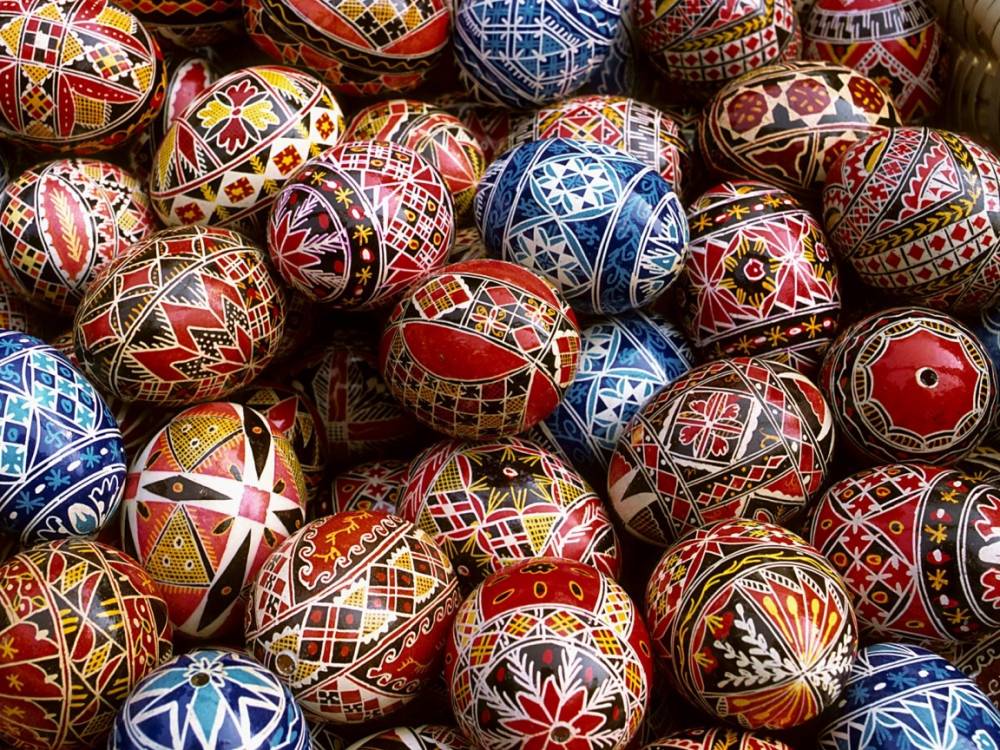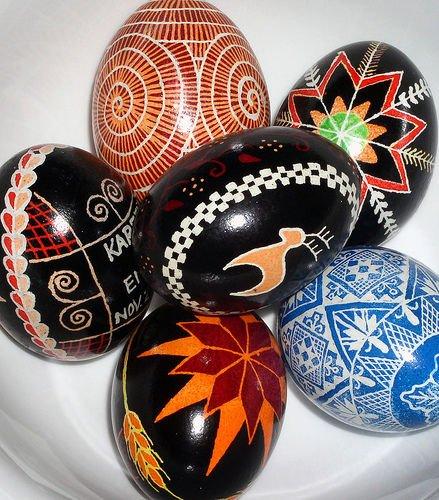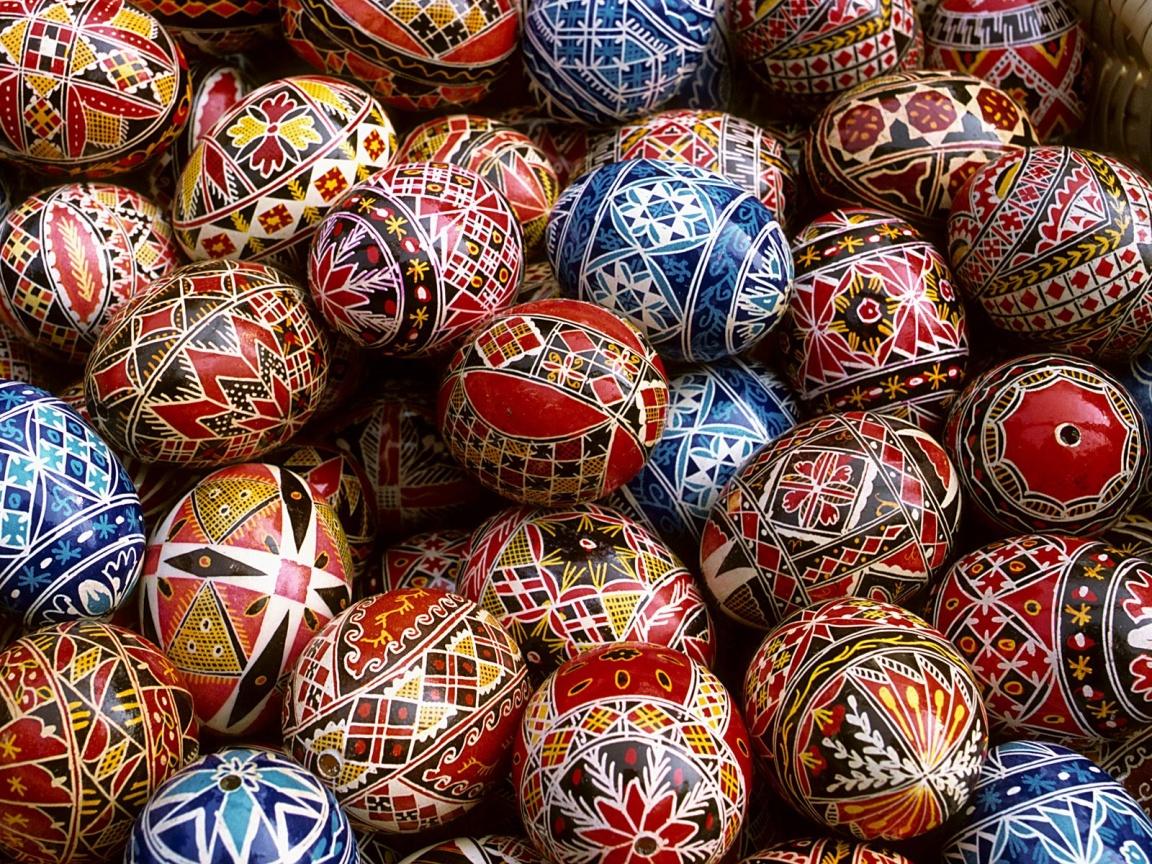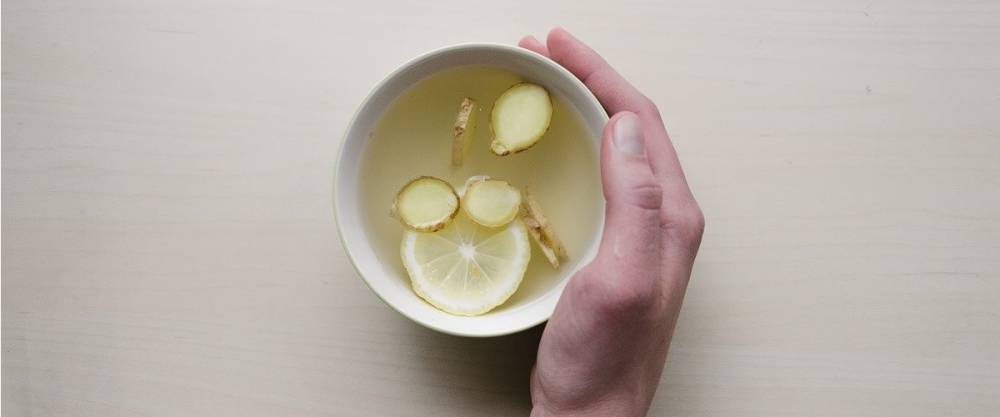Painting Easter eggs by batik method

30
April 2019
The method is similar to batik - patterns are drawn on the egg with wax, which then protects the covered areas from the dye that is applied. By repeating this process with different colors of dye, a multicolored pattern is built up. Finally, the wax is removed to reveal the colors that were covered up at each stage. A layer of polyurethane can be added over the finished egg to protect the dyed design and to give a gloss finish.
Traditionally, the eggs were left whole. They would eventually dry out and become light.
In Order to get a stronger shell, you should put the empty eggs in a very salty water for while, so the shell will get salt and be more strong.
Step 1. Materials needed:
- Eggs
- Pure Beeswax Block
- Candle
- Kistka = Chișca (Romanian)
- Dyes
- Pencil
- Heat Tool (optional)
- Paper Towels
Before you begin, WASH YOUR HANDS! Oils on your hands can get on the egg shells and cause uneven dyeing. It helps to make sure your hands are clean before you start handling the eggs.
Step 2. Designing
Draw your design guidelines on your egg in pencil. When the wax is removed later, it will remove these pencil lines with it. If you make a mistake, Do Not Erase! Erasing can scratch the egg shell surface causing uneven dying.



Step 3. Waxing
Heat the funnel of the kistka in the flame
of the candle& being careful to keep the tip of the funnel out of the flame. Soot from the flame can clog the tip if it is held directly in the flame. Soot from the flame will collect on the surface of the kistka (blackening it).
With the heated kistka, dip into the block of beeswax. The heat of the tool will melt the wax into a little puddle. Scoop molten wax from this puddle into the funnel of the tool. Soot on the kistka will mix with the wax and darken it as you continue to use the wax block. This is helpful, as the blackened wax is much easier to see than the natural wax while working on the egg shell.
Step 4. Caution!
Do Not Leave the Hot Kistka in the Wax Block! If it is left in the hot molten wax and then the wax hardens, it is difficult to remove the tool without damaging it.
Step 5. Draw on the Egg
Once your tool is full, you may need to reheat it. In order for the wax to flow well, the tool must be hot enough. Use the tool just as you would a pencil to draw on the surface of the egg everywhere that you would like the egg to remain white. It can be helpful to keep your pinky anchored on the egg surface to steady your hand.


Step 6. Dying
Carefully lower the egg into the dye with a spoon. Do Not Drop the Egg into the Dye! Dropping the egg can cause it to crack. Sometimes these cracks are not visible until the final wax removal stage after hours of work have been put into an egg.
The amount of time to leave an egg in the dye varies depending on the color of dye... if it is being dyed over another color... the quality of the shell surface... the age of the dye... and even more factors. So the only rule that can be used is to check often. Some dyes will make a decent color in just 15-20 seconds. Others take 5-10 minutes. For a strong color, you may have to leave an egg in the dye for quite some time!


Step 7. Remove the Egg
When your egg reaches the color you are looking for, remove the egg from the dye by lifting it up with the spoon... and then picking the egg up off the spoon with a paper towel.
Do not roll the egg off the spoon onto the paper towel, as this pour excess dye left in the bottom of the spoon into your hand as well.
Always use a clean paper towel for each egg. The same paper towel can be used for successive dye baths on the same egg... but if you used a paper towel on an egg that is contaminated with colors you have not already used on that egg, you can transfer dye from the towel onto your egg, marring it. Pat the excess dye off the egg.


Step 8. Clean Your Spoon!
Make sure to wipe off your spoon after putting an egg in or taking an egg out of a dye pot. Check before using a spoon that it is not covered in dye from a previous use. This excess dye can contaminate a dye pot, changing it’s color.


Step 9. Repeat for Multiple Colors
Repeat the Waxing and Dying steps for each color of dye in your design. Remember that the areas you are waxing are going to stay the color they are at the time you apply the wax. There is no need to apply wax over the final color of the design.


Step 10. Removing the Wax
The traditional way to remove wax from the eggs is with the heat of a candle flame. Hold the egg close to the candle flame until the wax softens and then wipe the melted wax away with a paper towel or a tissue. Be careful NOT to hold the egg in or directly over the flame! Holding the egg in the flame can transfer soot onto the surface of the egg. This soot will be almost impossible to remove and can ruin a beautiful egg.
Because of the danger of soot marring the egg, my favorite method of removing the wax is to heat the egg with a heat gun designed or rubber stamping. This method also allows me to remove the wax more quickly. There is a slight bit of cooking of the egg innards... but it doesn’t interfere with blowing the egg.


Step 11. Finished? or Not Finished?
Voila! Your done! Well, at least you can be... you can stop here and have a 100% authentic traditionally dyed egg. Eggs left whole (unblown) will eventually dry out over time. As the egg dries out, it releases gasses slowly through the shell. If the egg is kept in a open area with good circulation, this helps it age safely. If the egg is kept in an enclosed space (or sometimes just out of spite on the part of the egg) the gasses can build up and cause the egg to “pop” cracking it’s shell and ruining it. Exploding eggs do not smell good... are not fun to clean up... and can scare the heck out of you at 2 am. How do you avoid them?
Option 1: start with blown egg shells to dye. While this avoids all the potential problems of working with whole eggs, there is a major downside. Blown eggs float. In order to dye a blown egg, you need to plug the hole(s) with wax to keep it from filling with dye. This means that the blown egg acts like a balloon and needs to be constantly held below the surface of the dye. Whole eggs have the advantage of sinking in the dye and not needing supervision. Another disadvantage of this method is that the untreated dyed egg shell surface can be damaged by moisture and is more likely to fade.
Option 2: (our preferred) start with whole raw eggs to dye. After you are finished with the dyeing process and have removed the wax, coat the eggshell with a layer of oil-based polyurethane. It must be oil-based, because a water based polyurethane will run the dyes. The polyurethane will protect the dyed pattern from moisture and help prevent fading in strong light. It is still not advisable to store eggs in direct sunlight to prevent fading. The polyurethane also adds quite a bit of strength to the fragile egg shell. Once the egg is sealed, it can be blown without the egg innards marring the dyed design of the shell. As a final step, to make sure that any remaining egg inside the shell dries out, bake the finished egg in a low oven (somewhere around 150-175 degrees) for about an hour.


Step 12. Tips, Tricks, and Variations
A good way to get clear colors is to start with your lightest color first and work to darkest. It can be difficult to dye a light color over a dark color.
Working in one color family (yellows to reds or shades of blues) helps keep clear colors as well. That said, interesting effects can be obtained by breaking all the rules. Sometimes colors interact in surprising ways.
You can get an interesting “acid washed” look by rubbing the egg dry instead of patting when you remove it from the dye pot.
A light bleach solution can be used to remove colors from all non waxed sections of the egg, letting you have a white background color or giving you clear colors in future dye baths. Be careful, dyes don’t always give exactly the same color or saturation on a bleached shell.
Vinegar can be used to etch an egg’s shell. Used instead of dye, the vinegar will remove thin layers of shell creating a raised effect where the waxing is done. On a brown or green shell, the etched areas will be lighter and lighter shades fading towards white. multiple color tones can be created by waxing and etching repeatedly.
Vinegar etching can also be used to remove a layer of dying and give you a white shell again.
Wait to see your Easter Painted Eggs!!!




